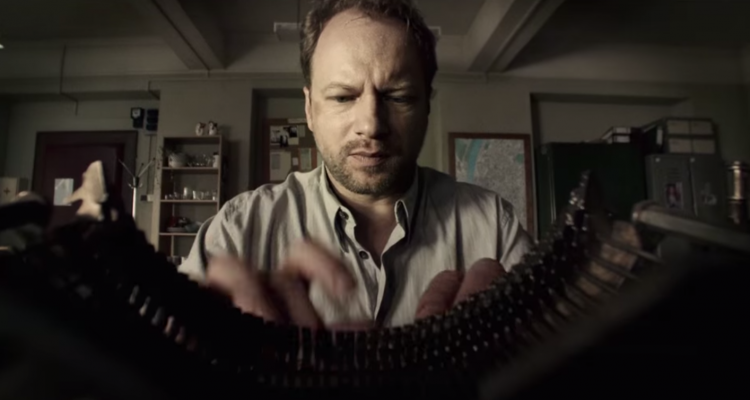Lying somewhere on the spectrum between the recent boom in so-called Scandi-noir and Tom Robb Smith‘s spy novel “Child 44” (which was also adapted into a film), Michal Kollár‘s gritty, occasionally gruesome “The Red Captain” makes a convincing case for a prestige TV series set in the fascinating period during Czechoslovakia’s post-communist dissolution into the Czech Republic and Slovakia. That also means, however, that the Transilvania International Film Festival title never quite coheres as a feature film, trying to cram far too much plot and texture into two hours, and potentially leaving viewers floundering, especially those of us less well-versed in the complexities of the religious, social, ideological and cultural divides that beset the nascent nations. However, if you’re wide awake and willing to keep up, and if you can overlook some rather cursory characterization and a slightly blank leading man in Maciej Stuhr, there’s enough tinkering, tailoring, soldiering and spying here to keep avid genre fans happy. And certainly this adaptation of Dominik Dán‘s regional-bestseller novel, in being one of the most expensive and lavishly mounted Czech/Slovak co-productions ever, looks the part, wrapping well-chosen details around that core of steely, cynical, righteous moralism that makes the noir-crime-story-meets-historical-fiction category so compelling.

In Bratislava, in 1992, six months prior to the city becoming the capital of its own nation, homicide detective Richard Krauz (Stuhr) and his cynical but loyal older partner Edo Burger (Marián Geisberg) land an unappealing case involving a skeleton with a nail in the base of its skull, which has been accidentally unearthed in the course of some construction. Burger, sensing a minefield, wants to file the case away. But Krauz, fresh from the successful solution of a serial-killer case, is dogged in his determination to unearth not just the culprit, but the motivation behind the grisly death and apparent perimortem torture. The body is discovered to be that of a priest, and thus a multitude of plots grind into action, involving high-level Church cover-ups, a secret file of damningly perverse photographs, a division of the former communist secret services called The Spiritual, and its now-gone-to-ground leader, nicknamed “The Red Captain,” for an incident in which he “painted the walls of a room with the guts” of one of his suspects. The investigation is thwarted by unhelpful citizenry who regard Krauz with distrust due to his association with the reviled secret police, and also by another officer placed in Krauz’ unit whose break with his past may not be as clean as Krauz’ own.
Technically, the production is impressive if slightly anonymous, with DP Kacper Fertacz saving most of his invention for a few showy, Hitchcockian flourishes like immense high overheads of Krauz running across a plaza, or for action set pieces like one of the (too) many climaxes, that occurs in a train station. But the period is accurately depicted in the locations, props and costuming, with Krauz’s pale blue jeans and omnipresent rickety Skodas doing a good job of evoking that heady period when Western-style democracy arrived a short moment before the fashions and other trappings of general Westernization. Everything is just a little bit tatty: the first shot is of Krauz smoothing down the “Police” decal on his car door where it’s become unstuck, and even the brutalist monoliths that represent Communism’s contribution to Bratislava’s architecture are crumbling at the edges.

But Krauz is a less compelling character when taken out of his well-observed context. His family life is scarcely touched on beyond including a daughter with some unspecified ailment and a wife whose sole function is to be constantly disappointed by his professional obsessiveness. More crucially, we’re never really sure where that obsessiveness springs from—Krauz is so driven to solve this case that he alienates almost everyone around him, and puts everyone he knows at risk, but why?
A few of the supporting characters fare better, particularly Burger, whose lugubrious pronouncements about human nature provide a few dry chuckles, as a well as the coroner who glances at the grotesque scene of a death by industrial circular saw, and deadpans “It’s definitely not psychosomatic.” But the villains are too many for us to keep track of, and the film has to end about thirteen times over just so we can find out what became of each member of this rogues’ gallery of corrupt priests, corrupt policemen, corrupt gangsters, corrupt politicians and corrupt ex-commies, including the titular captain.

This loss of focus is a pity, because inside “The Red Captain” there’s a terrific little thriller, or ten, and a glossy event-TV opportunity just dying to get out. You can easily see how this property could have put this region on the international entertainment map the way that “The Killing” or “Borgen” did for Danish episodic TV. Even its flaws, such as over-plotting could have been spun into virtues with a longer format: those too many endings feel like they’d make perfectly paced, perfectly placed cliffhangers to get us to tune back in for the next installment. Best of all there’s the sense that “The Red Captain,” as genre-indebted as it is, actually has a complex, well-earned point to make: At that time in Czechoslovakia, the authorities may have nominally no longer been Communist Party cadres, but aside from a few high-profile investigations and dismissals, they were still the very same individuals who exercised repression and terror tactics on a jaded population. If “The Red Captain” has one overriding theme, it’s the impossibility of true societal change when those in power are the same people who have always wielded it, just wearing different stripes: it’s about how revolutions can happen, and yet nothing really changes. [B-]

